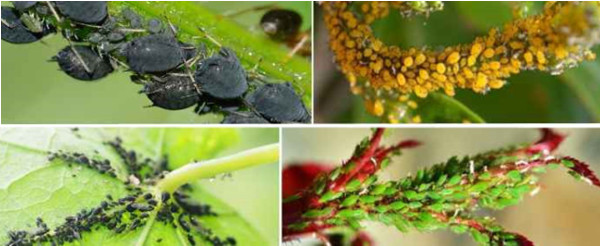What’s Biopesticides?
Biopesticides are preparations that use the substances or organisms (fungi, bacteria, insect viruses, genetically modified organisms, natural enemies, etc.) or their metabolites (pheromones, auxin, sodium naphthoacetate,2,4-D, etc.) to kill, damage or inhibit agricultural pests, also known as natural pesticides. They come from natural animals, plants or fungi and have bactericidal and insecticidal properties.
Biopesticides are biological substances and organisms that have been designed specifically for the purpose of controlling pests in agriculture. These substances are created through interactions between plants and their predators and beneficial insects. These biopesticides are not only safe for the environment, but they are effective alternatives to conventional chemical pesticides. Biopesticides do not build resistance to pests, so there is no risk of resistance development. Moreover, these natural products decompose rapidly. They are also less toxic to humans and the environment.
History of Biopesticides
The development of biopesticide has a long history, its laboratory research started in the 19th century.Agostino bassi reported for the first time the infectious disease of bombyx mori “Beauveria bassiana” caused by Beauveria bassiana in 1853, which proved that the parasite could grow and develop in the larvae of bombyx mori and spread the disease by inoculation, contact with or contaminated feed. Meichenikov of Russia applied Metarhizium anisopliae to control wheat beetle larvae in 1879; In 1901, Japanese man Shidu isolated a pathogenic bacillus from bombyx mori — Bacillus thuringiensis; In 1926 G.B. Fenford used antagonistic antibodies against potato scab. These are the early research basis of biopesticide.
The first generation of biopesticides, including nicotine, alkaloids, rotenones, pyrethroids and some vegetable oils, have been in use for much of human history. As early as 1690, the water-soluble content of tobacco was used to combat pests in cereals. In 1995, however, biopesticides accounted for 1.3 per cent of total world pesticide sales. China has become the world’s largest producer of pesticides, with output rising from 330,000 tons in 1983 to more than 3.7 million tons in 2014-2016. In 2020, the world’s biologics products exceeded $4 billion, with biopesticides and biostimulants accounting for half of the total.
Classification of biological pesticides
Biopesticides can be divided into several categories, depending on their function and origin. According to the standards of FAO, biopesticides are generally natural compounds or genetic modifiers, mainly including biochemical pesticides (pheromones, hormones, plant regulators, insect growth regulators) and microbial pesticides (fungi, bacteria, insect viruses, protozoa, or genetically modified microorganisms), and agricultural antibiotics are not included. Microbial pesticides are organic, biological pesticides that act on plants through biochemical changes. They are made from bacteria and fungi, which can penetrate insect cuticles and kill pests without harming the plants.
According to its composition and source, it can be divided into microbial pesticide, microbial metabolite pesticide, plant-based pesticide and animal-based pesticide. According to the objects controlled, it can be divided into insecticides, fungicides, herbicides, acaricides, rodenticides, plant growth regulators, etc. Fungicides, for example, work by killing pathogenic microorganisms. Examples of biological fungicides include Trichoderma spp., which has been used to control white root disease in rubber plants, and Fusarium wilt, which causes rotting roots in chili plants.
RNA interference (RNAi) is a new genetic mechanism used in biopesticides to target gene expression in insects. Its discovery in 1990 has made it a potentially effective tool for controlling crop pests and insect populations. The mechanism is sequence-dependent, highly species-specific, and involves double-stranded RNA. Insecticidal RNAi uses the DNA sequences of two insect species, one of which is beneficial to the pest. This approach is advantageous in that it can produce lethal phenotypes with low concentrations of dsRNA. Nanoparticles can also be used to deliver the dsRNA molecules to the target plant. Transgenic plants that express dsRNA containing hairpins have been shown to silence insect genes. These transgenic plants include tobacco (Nicotiana tabum) and thale cres (Arabidopsis thaliana).
Advantages of biopesticides
Biopesticides have several advantages over traditional chemicals. They are less toxic and very environmentally friendly because they are not toxic to non-target organisms and have no residual effects on non-target organisms. These pesticides are useful for controlling a wide range of pests, including insects and plant pathogens.
Less toxic and very environmentally friendly
Biological pesticides are mainly used by some special microorganisms or microbial metabolites that have insecticidal, disease prevention, and growth promotion functions to control pests. Fully present and derived from natural ecosystems, they are easily decomposed by sunlight, plants, or various soil microorganisms. Therefore, they can be considered safe and pollution-free to the natural ecological environment.
Control the propagation of pests
Microbial biopesticides contain microorganisms that are highly selective against pests. Some biopesticides (entomopathogenic fungi, insect viruses, insect microsporidium, entomopathogenic nematodes, etc.) have the ability of horizontal or vertical transegg transmission in pest groups and have the ability to colonize, spread and develop epidemic under certain conditions in the field. It can not only control the current pests, but also inhibit the pest population of the next generation or the next year.
Wide range of sources
Biopesticides are generally derived from natural renewable resources (such as corn, bean cakes, fish meal, wheat bran or some plants, etc.). Wide range of sources, low cost. Therefore, the production of biological pesticides will not compete with chemical synthetic pesticides for non-renewable resources (such as oil, coal, natural gas, etc.), more environmentally friendly.



